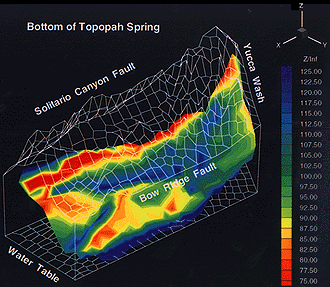





| 
| 
| 
| 
|

| This computer model of the Yucca Moutain, Nevada, proposed site of the nation's first permanent underground repository for high-level nuclear waste, shows the vertical flow of moisture within the moutain. |
 The Department of Energy has proposed constructing the nation's first
permanent underground repository at Yucca Mountain in Nevada. However, before the
repository can be constructed, the Yucca Mountain site must be thoroughly
characterized to ensure that once the nuclear waste is buried, none of it can
ever escape into the environment. Berkeley Lab earth scientists, working in
conjunction with the U.S. Geological Survey, have developed a three-dimensional
site-scale computer model of Yucca Mountain. The model simulates the flow of
moisture, gas, and heat through the unsaturated zone (the soil between the ground
surface and the water table) of the site. For the safe containment of the nuclear
waste, it is essential to know how much water percolates through the unsaturated
zone and to what degree it picks up radionuclides. Waste managers must also know
how rapidly air that could contain gaseous radionuclides flows to the ground
surface. The Berkeley Lab computer model allows users to predict the results of
any abrupt changes in climatic conditions on moisture and gas flow through the
unsaturated zone and its major faults and fracture zones.
The Department of Energy has proposed constructing the nation's first
permanent underground repository at Yucca Mountain in Nevada. However, before the
repository can be constructed, the Yucca Mountain site must be thoroughly
characterized to ensure that once the nuclear waste is buried, none of it can
ever escape into the environment. Berkeley Lab earth scientists, working in
conjunction with the U.S. Geological Survey, have developed a three-dimensional
site-scale computer model of Yucca Mountain. The model simulates the flow of
moisture, gas, and heat through the unsaturated zone (the soil between the ground
surface and the water table) of the site. For the safe containment of the nuclear
waste, it is essential to know how much water percolates through the unsaturated
zone and to what degree it picks up radionuclides. Waste managers must also know
how rapidly air that could contain gaseous radionuclides flows to the ground
surface. The Berkeley Lab computer model allows users to predict the results of
any abrupt changes in climatic conditions on moisture and gas flow through the
unsaturated zone and its major faults and fracture zones.
 Another dramatic manifestation of the cause and effect relationship between
energy and environment can be seen-literally-in the Los Angeles basin, where the
enormous reliance on automobiles has taken a severe toll on air quality. A recent
plan to reduce ozone in the Los Angeles air basin calls for a 75-percent
reduction in the emission of nitrogen oxides and reactive organic gases using
unspecified technologies. Many have questioned the cost and technical feasibility
of this plan. To provide a better understanding of ozone-formation in air basins,
Berkeley Lab scientists have begun to develop an ambitious computer model. This
model will enable users to investigate-through computer simulations-alternative
ozone reduction strategies that could prove more practical and cost-effective
than the current plan for Los Angeles. Early in its development, the model has
already been used to demonstrate that reducing emissions to different levels in
different areas of the basin would achieve the same air quality as the current
strategy with only modest controls required. For example, emissions reductions of
30 to 50-percent in select basin areas yield air quality results comparable to
the 75-percent basin-wide reductions now proposed.
Another dramatic manifestation of the cause and effect relationship between
energy and environment can be seen-literally-in the Los Angeles basin, where the
enormous reliance on automobiles has taken a severe toll on air quality. A recent
plan to reduce ozone in the Los Angeles air basin calls for a 75-percent
reduction in the emission of nitrogen oxides and reactive organic gases using
unspecified technologies. Many have questioned the cost and technical feasibility
of this plan. To provide a better understanding of ozone-formation in air basins,
Berkeley Lab scientists have begun to develop an ambitious computer model. This
model will enable users to investigate-through computer simulations-alternative
ozone reduction strategies that could prove more practical and cost-effective
than the current plan for Los Angeles. Early in its development, the model has
already been used to demonstrate that reducing emissions to different levels in
different areas of the basin would achieve the same air quality as the current
strategy with only modest controls required. For example, emissions reductions of
30 to 50-percent in select basin areas yield air quality results comparable to
the 75-percent basin-wide reductions now proposed.

| 
| 
| 
|